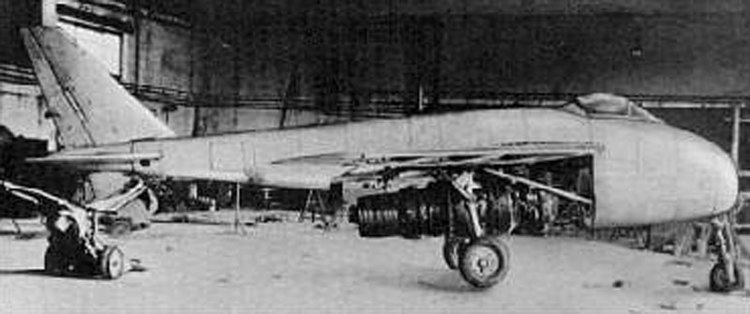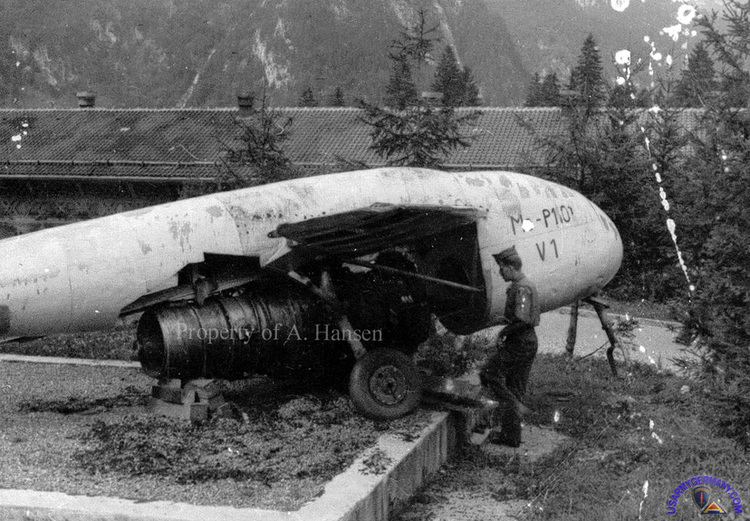Range 1,500 km Manufacturer Messerschmitt | Engine type Heinkel HeS 011 Designer Willy Messerschmitt | |
 | ||
Messerschmitt p 1101 war documentary
The Messerschmitt P.1101 was a single-seat, single-jet fighter project developed in response to the 15 July 1944 Emergency Fighter Program, which sought the second generation of jet fighters for the Third Reich. A characteristic feature of the P.1101 prototype was that the sweep of the wings could be changed before flight, a feature further developed in later variable-sweep aircraft such as the Bell X-5 and Grumman XF10F Jaguar.
Contents
- Messerschmitt p 1101 war documentary
- Design and development
- Production prototype
- Postwar
- Me P1101 First Design
- Me P1101 Second Design
- Me P1101 Third Design
- Me P1101 Fourth Design
- Me P1101 L
- Me P110192
- Me P110199
- Specifications P1101 fourth design
- References

Design and development

Within nine days of the 15 July 1944 issuance of the design specifications for the Emergency Fighter, the Messerschmitt design bureau under Dr. Woldemar Voigt had formed a preliminary paper design for the P.1101. The aircraft which was developed initially had a short and wide fuselage, tricycle landing gear, and mid-mounted wings with an inner sweep of 40° near the fuselage, and a shallower 26° outboard. The single HeS 011 jet engine was to be mounted internally within the fuselage, being aspirated by two rounded intakes located on either side of the cockpit. The high tail was of a V configuration, and mounted on a tapered boom which extended over and past the jet exhaust, while the cockpit was forward mounted, with the canopy integrated into the fuselage and forming part of the rounded nose of the aircraft.

By late August 1944, the design still in paper form had evolved into a sleeker incarnation, with the previously stout fuselage lengthened and narrowed with a conical nose section added in front of the cockpit. The compound sweep wing was also abandoned, with the outer wing of the Me 262 instead being adapted. Proposals for a pulsejet and rocket combination, the P.1101L, were also put forth. The design was further developed, including a longer nose, and after the wind tunnel testing of a number of wing and fuselage profiles, the decision was made to undertake the construction of a full-scale test aircraft. This finalized design and associated test data were submitted to the Construction Bureau on 10 November 1944 and the selection of production materials was begun on 4 December 1944.

On 28 February 1945, the RLM settled on a competing design, the Focke-Wulf Ta 183, as the winner of the Emergency Fighter program. This decision was based in part on the considerable design difficulties being encountered by the Messerschmitt P.1101 design team. For example, the cannon installation was proving too crowded, the mainwheel retraction and door mechanisms were too complex, the fuselage needed a great number of "strong points" to deal with loads, and the anticipated performance had fallen below the RLM specifications due to increased weight.
Production prototype

Since considerable work had already been done on the P.1101 design, the RLM decided to continue reduced funding in order for Messerschmitt to carry out experimental flights testing the swept back wing at anticipated speeds up to Mach 1. The worsening war situation led to the expedited, but risky, approach of building a full-scale prototype in parallel with detail construction and continuing statistical calculation, while existing components such as the wings (Me 262), landing gear (extended Bf 109), and flight components were utilized where feasible. It was also intended for the test flights to be conducted with 35, 40, and 45 degree wing sweep. Production of the V1 prototype was begun at Messerschmitt's Bavarian Oberammergau Complex with a projected first flight in June 1945.
The P.1101 V1 prototype was of duralumin fuselage construction, retained the outer wing section of the Me 262 but with larger slats and, as mentioned previously, the wing sweep could be adjusted on the ground from 30, 40, to 45 degrees; this was for testing only and never intended as an operational feature. The fuselage-mounted tandem intakes of the preliminary designs were replaced by a single nose intake, and the canopy became a bubble design, which afforded better all-around vision than the initial integrated canopy offered. The production prototype also incorporated a more conventional swept tail design, which was constructed out of wood and remained mounted on the tapered tail boom. A T-tail was also designed. The tricycle undercarriage consisted of a steerable, rear retracting nose wheel and long forward-retracting wing root mounted main gear. The prototype was fitted with an apparently inoperable Heinkel He S 011 jet engine, but given the non-availability of this engine, a Jumo 004B was fitted for test flights. (Changing the type of engine was meant to be comparatively easy.) In addition, the production model was to be equipped with a pressurized cockpit and armored canopy, and to be armed with two or four 30 mm (1.2 in) MK 108 cannons, Ruhrstahl X-4 air-to-air missiles, or both.
Postwar
By the time an American infantry unit discovered the Oberammergau complex on 29 April 1945, the V1 prototype was approximately 80% complete. Wings were not yet attached and appear to have never had skinning applied to their undersides. The airframe was removed from the nearby tunnel in which it was hidden and all associated documents were seized. There was some lobbying by Messerschmitt Chief Designer Woldemar Voigt and Robert J. Woods of Bell Aircraft to have the P.1101 V1 completed by June 1945, but this was precluded by the destruction of some critical documents and the refusal of the French to release the remaining majority of the design documents (microfilmed and buried by the Germans), which they had obtained prior to the arrival of American units to the area.
The airframe meanwhile became a favorite prop for GI souvenir photos. Later the prototype was shipped first to Wright Patterson AFB, then to the Bell Aircraft Works in Buffalo, New York in 1948. Damage ruled out any possibility for repair although some of the Me P.1101's design features were subsequently used by Bell as the basis for the Bell X-5, which was the first aircraft capable of varying its wing geometry while in flight.
Me P.1101 First Design
The July 24, 1944 design by Hans Hornung of a single-seat jet fighter. It was powered by one Heinkel He S 011 turbojet. This was the shortest of all versions with a blunt nose and a v-tail. It had a wingspan of 7.15 m and a length of 6.85 m. The armament was two MK 108 cannons.
Me P.1101 Second Design
August 30, 1944 sleeker design. Also a v-tailed single-seat jet fighter with a more pointed nose and wings swept back at 40 degrees. It had a wingspan of 8.16 m and a length of 9.37 m.
Me P.1101 Third Design
Full-scale prototype design of a flying test single-seat jet fighter with a wingspan of 8.06 m and a length of 8.98 m. It had a conventional tail and swept wings designed to be set at different angles while on the ground. Test flights were first intended to be undertaken with a 35 degree wing sweep, followed by a 45 degree sweep. The first test flight was to take place in June 1945.
Me P.1101 Fourth Design
The final single-seat jet fighter design that went into production with a wingspan of 8.25 m, a length of 9.175 m and a weight of 1250 kg.
Me P.1101 L
A ramjet-powered single-seat fighter that would have eight additional small rocket engines for take-off. This design would have a much wider fuselage covering the large Lorin ramjet located to the back of the cockpit, as well as a conventional tail.
Me P.1101/92
A different design of a two-seat v-tailed heavy fighter and destroyer. It was an all-metal aircraft armed with a large 7.5 cm Pak 40 cannon and was powered by two Heinkel He S 011 turbojets. It had a wingspan of 13.28 m and a length of 13.1 m.
Me P.1101/99
Another very different variant altogether. Two-seat attack/destroyer all-metal aircraft powered by four Heinkel He S 011 turbojets. It had the cockpit at the front end of the fuselage and was armed with a 7.5 cm Pak 40 cannon and five MK 112 55 mm cannons. Its tail was of the conventional type and it had a wingspan of 15.4 m and a length of 15.2 m.
Specifications (P.1101 fourth design)
General characteristics
Performance
Armament
